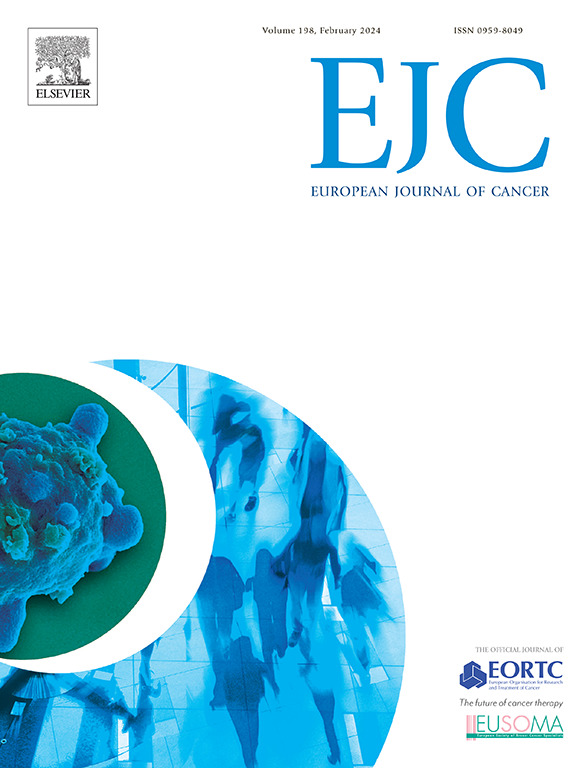Plasma Epstein-Barr virus DNA for disease surveillance in endemic nasopharyngeal carcinoma: Analysis of a real-world database
IF 7.6
1区 医学
Q1 ONCOLOGY
引用次数: 0
Abstract
Aim
Plasma Epstein-Barr virus (EBV) DNA is an archetypal biomarker for endemic nasopharyngeal carcinoma (NPC) employed for disease surveillance and early detection of recurrences. However, its accuracy is unknown. We utilised a single institution dataset with homogeneous surveillance procedures and routine EBV DNA testing using a harmonised assay to investigate its accuracy for recurrence detection.
Methods
We utilised a cohort of patients with histologically-confirmed, non-metastatic NPC treated from February, 2017 to July, 2023. All patients had ≥ 1 EBV DNA test using the harmonised BamHI-W polymerase chain reaction-based assay within 3 years post-radiotherapy (RT). We analysed the negative (NPV) and positive predictive values (PPV) for recurrence over a 1-year window (at 3-monthly intervals – windows 1–4) for each test performed. Recurrence was ascertained by radiological imaging and/or histopathological confirmation.
Results
Of 1746 EBV DNA readings from 393 patients diagnosed between January, 2017 to May, 2023, 1385 (79.3 %), 294 (16.8 %), and 67 (3.9 %) were recorded as negative, low (< 500 copies/mL), and high EBV DNA (≥ 500 copies/mL), respectively. NPVs of the assay were high (range: 97.6–99.3 %). PPVs were modest, highest at window 1 (range: 26.3–34.3 %) compared with the other 3 windows (range: 2.6–10.5 %). Sensitivity analyses revealed that PPVs were threshold-dependent; 71.4–100 % at window 1 for ≥ 500 copies/mL versus 16.9–23.1 % for < 500 copies/mL, which corresponded to median time of recurrence onset (0.8 vs 4.8 months, respectively).
Conclusions
Negative EBV DNA test results have high NPVs, suggesting that patients may be routinely surveyed, while a positive result of ≥ 500 copies/mL indicates high recurrence risk.
血浆eb病毒DNA用于地方性鼻咽癌疾病监测:对真实世界数据库的分析
Epstein-Barr病毒(EBV) DNA是鼻咽癌(NPC)疾病监测和早期复发检测的典型生物标志物。然而,其准确性是未知的。我们利用单一机构数据集,采用均匀的监测程序和常规EBV DNA检测,使用统一的分析方法来研究其复发检测的准确性。方法:我们选取了一组于2017年2月至2023年7月接受组织学证实、非转移性鼻咽癌治疗的患者。所有患者放疗后(RT) 3年内采用统一的BamHI-W聚合酶链反应法进行EBV DNA检测≥ 1。我们分析了每项检测在1年内(每3个月间隔-窗口1-4)复发的阴性(NPV)和阳性预测值(PPV)。复发是通过放射成像和/或组织病理学证实。结果在2017年1月至2023年5月诊断的393例患者的1746份EBV DNA读数中,1385例(79.3% %),294例(16.8 %)和67例(3.9 %)记录为阴性,低(<;500拷贝/mL), EBV DNA含量高(≥500拷贝/mL)。npv值较高(范围:97.6 ~ 99.3 %)。ppv适中,与其他3个窗口(范围:2.6-10.5 %)相比,窗口1最高(范围:26.3-34.3 %)。敏感性分析显示ppv是阈值依赖性的;≥ 500拷贝/mL的患者在窗口1时为71.4-100 %,而<; 500拷贝/mL的患者为16.9-23.1 %,对应于中位复发时间(分别为0.8个月和4.8个月)。结论EBV DNA检测阴性患者npv值高,提示可常规检查,阳性≥ 500拷贝/mL提示复发风险高。
本文章由计算机程序翻译,如有差异,请以英文原文为准。
求助全文
约1分钟内获得全文
求助全文
来源期刊

European Journal of Cancer
医学-肿瘤学
CiteScore
11.50
自引率
4.80%
发文量
953
审稿时长
23 days
期刊介绍:
The European Journal of Cancer (EJC) serves as a comprehensive platform integrating preclinical, digital, translational, and clinical research across the spectrum of cancer. From epidemiology, carcinogenesis, and biology to groundbreaking innovations in cancer treatment and patient care, the journal covers a wide array of topics. We publish original research, reviews, previews, editorial comments, and correspondence, fostering dialogue and advancement in the fight against cancer. Join us in our mission to drive progress and improve outcomes in cancer research and patient care.
 求助内容:
求助内容: 应助结果提醒方式:
应助结果提醒方式:


